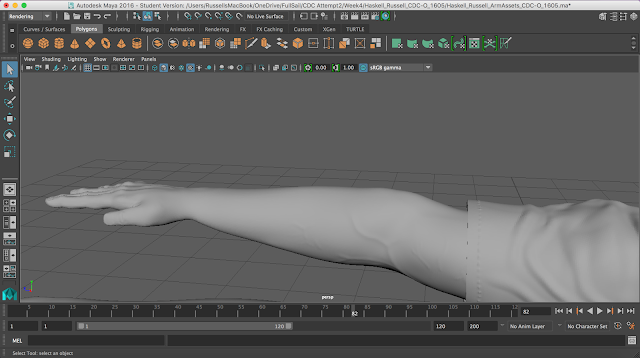Character Design and Creation Final Project
The final project for my Character Design and Creation class at FullSail University had its fair share of challenges but over wall was a very rewarding experience.
What worked and what didn't?
I had some issues with sculpting in z-brush but my main issue was connecting the fingers to the hand. I thought I had done everything correctly when it came to combining the meshes but it is apparent that there were some issues when the seam between the hands and fingers didn't want to smooth out properly. It took me a while but I figured out that I hadn't re-meshed the sculpt properly and when I re-meshed it went much smoother. I learned a lot about re-surfacing in maya when I was working on this project. I found out you can use your normal extrude tools when you are resurfacing and things still follow the shape of the object being re-surfaced. I only discovered this when I reached the hand but it made re-surfacing go much faster because I could extrude whole edges instead of just going block by block.
What Would I do differently next time?
If I were to do this again I would have taken more notes while I was working and taken more screen shots so that I had more content for this portion of the assignment. I did grab a few screen shots but I didn't get enough to really show the full development of the project. Also the project was so time consuming I cant really remember a lot of the specific issues I had with the project that I can share in this break down. I would also make sure the re-mesh properly to begin with when connecting the finger to the hand. Because of this I don't think things look exactly right in this area of the model.
Did you encounter any major issues, if so, how did you adapt?
I had a few hiccups along the way on this project as mentioned earlier there was issues with z-brush but I also had an issue with building the mesh for my arm. The issue was with integrating box junction on the knuckles and elbows and other joints. The reason this was an issue for me is because my mesh was already very dense to trying to integrate the box junctions seemed over kill when it came to the density of the mesh. I did insert normal box junctions at the elbow but instead of doing full box junctions on the knuckles I opted to make just the closing portion of the box junction so like half a box junction just to loosen the mesh a bit so it wasn't so dense and that way by the time I got to the finger tips it was much easier to close off the mesh.
Here you can see the way I utilized just the closing portion of the box junctions to declutter the mesh a bit.
How did the end result come out?
The final product of all my work came out okay. I mean I am satisfied and it doesn't have any major issues and it passes off as a fairly nice model. Upon close inspection however I think there is definitely a lot of space for improvement. The mesh works over all but there are some places where I think it could have been planned out better. The problem early on with z-brush left some issues with the fingers including an issue with the normal map between the fingers so things there don't look all that great. The model could use some polishing but over all I think I am moving in the right direction.
Here is an image of the base arm and sleeve that was made in z-brush prior to any major sculpting.

Here is an image of the final sculpted version of the arm and sleeve from z-brush.
Here is an image of the final resurfaced arm and sleeve after it has had its normal map applied.






















